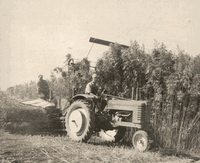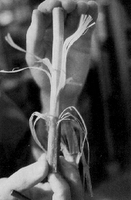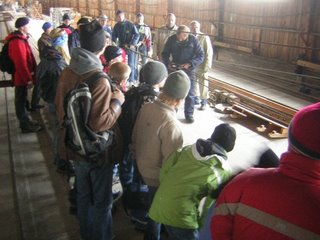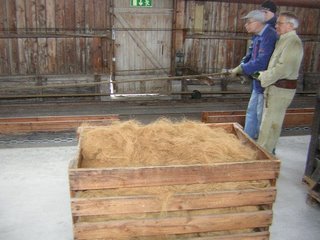Älvängen ropewalk...
 So here we are, the morning of Day 2 of my westward adventure, waking up to a gloomy overcast day at the Älvängen Ropemaking Museum after an incredibly loud night of snoring Viking ship sailors in the museum's hemp exhibit; they even managed to drown out the freight trains roaring by.
So here we are, the morning of Day 2 of my westward adventure, waking up to a gloomy overcast day at the Älvängen Ropemaking Museum after an incredibly loud night of snoring Viking ship sailors in the museum's hemp exhibit; they even managed to drown out the freight trains roaring by. But where are we, really? (in Natspeak that means 'where are we historically?')
But where are we, really? (in Natspeak that means 'where are we historically?') Of more recent fame, the museum that has opened in the P.A.C. ropewalk made all the rigging for the East Indiaman, Götheborg--now nearing the coast of Australia on its 10-month voyage to China. Ole supervised the laying of most of her rope right here in this facility.
 Remnants of the factory's working days are everywhere in these old buildings, usually in the form of wooden crates filled with cut-off rope ends or sacks of fiber waiting to be spun into yarn. Naturally I had to spend every spare minute I could find snooping and rummaging. Such cool stuff lying around... Elsewhere I ran into piles of rusty tools, stacks of pallets, and a paint shed full of rusted cans and solidified cakes of the trademark light yellow paint of the factory buildings.
Remnants of the factory's working days are everywhere in these old buildings, usually in the form of wooden crates filled with cut-off rope ends or sacks of fiber waiting to be spun into yarn. Naturally I had to spend every spare minute I could find snooping and rummaging. Such cool stuff lying around... Elsewhere I ran into piles of rusty tools, stacks of pallets, and a paint shed full of rusted cans and solidified cakes of the trademark light yellow paint of the factory buildings.  But there have certainly been some changes in some parts of the old plant, principally here in the ropewalk complex itself. This was once a rope-storage room connected to the ropewalk. Now, the museum's staff and their small army of volunteers have transformed it into an exhibit hall complete with a gift shop, special event space, and a kitchen--it is really an entire indoor village. I mean...we did live there for two days.
But there have certainly been some changes in some parts of the old plant, principally here in the ropewalk complex itself. This was once a rope-storage room connected to the ropewalk. Now, the museum's staff and their small army of volunteers have transformed it into an exhibit hall complete with a gift shop, special event space, and a kitchen--it is really an entire indoor village. I mean...we did live there for two days.  I can't say that such a mode of interior decor meets my tastes, but through a mixture of these constructions and some very well done interpretive exhibits, the museum has done a really nice job of showcasing and teaching about the history of both the handcraft and the industry of rope-making.
I can't say that such a mode of interior decor meets my tastes, but through a mixture of these constructions and some very well done interpretive exhibits, the museum has done a really nice job of showcasing and teaching about the history of both the handcraft and the industry of rope-making.  In part, this level of success seems to be the result of having so many wonderful collection items that visually describe the complex processes. Here, a few tools, some rope, and a small text label artfully explain how ropes were armored with 'serving' or 'worming' and why. Well done....
In part, this level of success seems to be the result of having so many wonderful collection items that visually describe the complex processes. Here, a few tools, some rope, and a small text label artfully explain how ropes were armored with 'serving' or 'worming' and why. Well done....
(Please pardon me; as a student of museum design I cannot refrain from analyzing these kinds of details and making assessments of exhibition education theory and stylistic design. It is in my nature now...)
 But we are not here to study exhibit design or to enjoy a museum visit; we are here to work and work hard. We have two days to make an entirely new suit of rigging for the Viking Ship replica Sife Ege. There is no time to be lost...
But we are not here to study exhibit design or to enjoy a museum visit; we are here to work and work hard. We have two days to make an entirely new suit of rigging for the Viking Ship replica Sife Ege. There is no time to be lost...  After the previous evening's introduction, everybody is more or less ready to begin at 0900. Breakfast has been devoured (cheese, cucumber, onions and the like on brown bread. I am definitely with Danes here), and everyone is bundled up and waiting in the unheated ropewalk. Ole and Annette enter and the show begins...
After the previous evening's introduction, everybody is more or less ready to begin at 0900. Breakfast has been devoured (cheese, cucumber, onions and the like on brown bread. I am definitely with Danes here), and everyone is bundled up and waiting in the unheated ropewalk. Ole and Annette enter and the show begins...  Now, I must digress a moment and comment on this building again. I was impressed to see the way the ropewalk disappeared into the darkness the night before, but now that it is in full light it is possible to really appreciate the length of this place, 300 meters to the end of the hall--and if the doors are opened and the drawbridge lowered at the far end, a 350-meter rope can be laid in this facility! I always knew Mystic Seaport had only a section of a ropewalk, but this place really puts things in perspective.
Now, I must digress a moment and comment on this building again. I was impressed to see the way the ropewalk disappeared into the darkness the night before, but now that it is in full light it is possible to really appreciate the length of this place, 300 meters to the end of the hall--and if the doors are opened and the drawbridge lowered at the far end, a 350-meter rope can be laid in this facility! I always knew Mystic Seaport had only a section of a ropewalk, but this place really puts things in perspective.Another thing to notice here is the tracks. There are two sets of these narrow rails in here running the entire length of the building.

On these tracks rides these little cars (only about a ton each). This cart with its thicket of gnashing gears rolls down the track at a steady pace while twisting the rope strangs fastened to its spinning steel hooks. It can just twist them, or it can wind them together, or it can braid them--this is a very 'talented' machine.
But such machines were the blessings of the 19th Century. Sif Ege and her Viking sisterships predated this contraption by nearly a millenium. Prior to its invention, all rope-laying work had to be done by hand or with simple cranks--just as we are going to do here for the next two days(yes, we will cheat from time to time and use the ropewalk cart to spin the strangs for us, but we'll do all the laying ourselves).
Now, to make a rope...
Let's back up just a little bit and start the process from the beginning...

First the hemp (standard rope-making material from ca.1450-1950) is harvested and taken to a pond or flooded field to soak.
 (Naturally, this was done by hand for centuries before the tractor came along, but the photos I have date from the machine age so we'll follow the modern hemp processing 'thread'. The handworkers of olde would have put the hemp through all the same tortures, but by hand of course.)
(Naturally, this was done by hand for centuries before the tractor came along, but the photos I have date from the machine age so we'll follow the modern hemp processing 'thread'. The handworkers of olde would have put the hemp through all the same tortures, but by hand of course.) 
After a day or two of soaking, the long fibers that make hemp such an excellent rope-making material begin to separate from the stalk and are ready to be processed.

First, the stalks are beaten and dragged over a bed of iron spikes that strips off the fibers. Then the fibers are beaten and dragged over the spikes further until they are separated into very thin, refined fibers.

Next, the fibers are further refined in a machine that strips them apart until the hemp is reduced to silky mass of long fibers (up to 3 meters long).

These fluffy piles of fiber are then gathered into tubs and taken to the spinning room.

In the spinning room the fibers are fed through a guide and spun into a single yarn. Gathered on a spool, the yarn is then taken to the tar-works to be run through a tank of hot tar that will impregnate the yarn with this vital preservative.
 This is the stage of Sif Ege's new set of rigging when we arrived at Älvängen. Anders and Bengt, the two full-time workers at the ropewalk, had already spun thousands of meters of yarn and run them through the tar-works. We found them on spools, reserved and waiting for Ole to transform them into the rigging of the Sif Ege.
This is the stage of Sif Ege's new set of rigging when we arrived at Älvängen. Anders and Bengt, the two full-time workers at the ropewalk, had already spun thousands of meters of yarn and run them through the tar-works. We found them on spools, reserved and waiting for Ole to transform them into the rigging of the Sif Ege.
Cheating and using the mechanical equipment to get started (we only had two days for goodness sakes!), we loaded the spools of tarred yarn onto pegs on an enormous free-standing wall. This wall had pegs for over 200 spools of yarn--the makings of a fairly heavy rope. Then the individual yarns were fed forward to the feeder guide (in background).

Here the yarns come together, feeding through this special circular guide that lines them up to be spun into a single cord or strang.

After passing through the guides, the yarns are tied to one of the spinning hooks on the ropewalk cart.

The ratio of turns-per-distance is controlled by choosing one of these gears and inserting it into the tangle of machinery that drives the little mecahnical cart down the track and spins its array of steel hooks. Choosing the right gear is critical as it will affect the internal balance of the rope and determine whether it kinks, curls, or just unravells.
Cheating and using the rope-walk car we hitched the 45 yarns from the peg wall onto one of the spinning hooks and sent the contraption banging and clattering down the track. Back on the peg wall, the 45 spools began to spin, steadily paying out yarn that ran through the uniting circular guide and then on toward the car working its way down the track.

In just five minutes we have a lovely strang made of 45 tarred hemp yarns beautifully and uniformly spun together. As each 110 meter strang is completed (it's just little viking boat, we don't need the whole ropewalk), it was cut off from the spools and hung on the wall to wait until we had enough to 'lay' a complete rope.
 When we had three strangs ready to go, Ole and Bengt took them down off the wall and we moved them to the center of the hall to stretch them out for laying.
When we had three strangs ready to go, Ole and Bengt took them down off the wall and we moved them to the center of the hall to stretch them out for laying.
Meanwhile the traditional ropewalk was set up between the tracks; a row of wooden frames to support the strangs as we tensioned them and began to lay them together (the machine method had these supportive frames too. They were hinged to allow the cart to pass and stuck out from the walls. See left side).

Once laid out on the frames, we tensioned the strangs. One end was secured to hooks on iron crank handles mounted in wooden stocks while the other end was kept relatively free but taught by lashing it to a special belt. Here, Torben (the Sif Ege's skipper and head of the organization) leans his weight against the strangs, stretching them slightly and evening out any imperfections in the laying of the yarns.

Then we ahd to smooth down the strangs by winding a short piece of line around them and dragging it the length of the strang. This was really tough work, especially on the first pass when the strang was rough and loose fibers hung out everywhere. By smoothing the strangs we can be sure the rope will also be smooth and uniform and therefore, stronger.

Next, Ole fits the top (the buoy-shaped wooden guide in his hand) between the three strangs and sets them into the deep grooves in the sides of the top. Then Torben 'cracks' the strangs to test them and see if they are wound tight enough to begin actually laying the 'rope.'

Then the crankmen at either end of the stretched trio of strangs begin turning their handles, rotating the three strangs together like a giant shaft. Meanwhile, Ole slowly advances the top which--because it is not turning--lays the strangs together and a rope is born. It continues to grow as Ole slowly makes his way down the floor, keeping an even pace and producing a wonderfully uniform line.

Minute by minute, crank by crank, the rope grows until additional people with pulling sticks are needed along its length to keep it turning over at the proper rate. Here the two anchors and a crankman at one end of the line. Because the strangs must wrap around eachother, the rope is constantly getting shorter as it is made (about 10m lost for every 100 produced) so this little trio is always inching forward in slips and lurches as the line tethering them to the far end of the ropewalk shortens.
The crankman here has an unexpectedly difficult job. It is crucial that he turn his crank at the same speed as those at the other end and thus keep the strangs turning as a single unit-however, given the distance to the other end it is often hard to see how fast the others are cranking.
 At one point, a tour group of school children came in to watch Ole perform his skill. Judging by the hush that fell over them and then the quiet 'ooing', they were rather impressed.
At one point, a tour group of school children came in to watch Ole perform his skill. Judging by the hush that fell over them and then the quiet 'ooing', they were rather impressed. Eventually, Ole handed the sacred duty of maneuvering the top over to Torben. A little shakey at first, Torben soon struck a rythm and began laying rope he could be proud of.
Eventually, Ole handed the sacred duty of maneuvering the top over to Torben. A little shakey at first, Torben soon struck a rythm and began laying rope he could be proud of.
After about 15 to 20 minutes, Torben reaches the end of the ropewalk and the first of the ropes that will carry his graceful little Sif Ege under all kinds of weather has been completed.
Note the stocks at the right where the end of the strangs are secured to three iron hooks on a united crankhandle are mounted.

Next, the rope is removed from the cranking hooks and secured between an iron post on one end and and a block and tackle on the other. Then we all piled onto the tackle and hauled for all we were worth, eight people groaning and grunting as the new rope stretched out and took the strain. Then, gasping and slipping, we held the line while Anders lashed it down.

Stretching the rope is absolutly key. This evens out and balances the forces between the strangs and prevents kinking and curling in the finished rope. Held under this enormous strain, the rope lies for a half-hour or more, slowly settling.
Note block and tackle alongside the storage trough. The new rope extends away from the block.

The
strangs are pulled so tight that the tar is squeezed right out of the yarns, bubbling up to the surface of the rope in a shiny, black--and very sticky--film. Despite the tarry mess I could not resist going up to the line and plucking it jsut to see how taught it was. My Lord!! This is a 100 meter rope with a 10 meter block and tackle system off one end. Even over that huge distance it is impossible to pull the taught rope even a few inches sideways. There is literally tons of pressure on the line---and it's taking it just fine. There's nothing quite like natural fibers.
Despite the tarry mess I could not resist going up to the line and plucking it jsut to see how taught it was. My Lord!! This is a 100 meter rope with a 10 meter block and tackle system off one end. Even over that huge distance it is impossible to pull the taught rope even a few inches sideways. There is literally tons of pressure on the line---and it's taking it just fine. There's nothing quite like natural fibers.  Thus the first line for Sif Ege's new rig was completed under the watchful and skilled eyes of Ole and Annette. Thanks to Ole and his skill, the Viking replica would be a little more authentic with its hand-made, natural fiber ropes....but that was just the first one...
Thus the first line for Sif Ege's new rig was completed under the watchful and skilled eyes of Ole and Annette. Thanks to Ole and his skill, the Viking replica would be a little more authentic with its hand-made, natural fiber ropes....but that was just the first one... After being stretched out, the rope was coiled down on a pallet and set aside as the ropewalk cart rattled down the track, spinning yarns into new strangs for the next rope.
After being stretched out, the rope was coiled down on a pallet and set aside as the ropewalk cart rattled down the track, spinning yarns into new strangs for the next rope. For the next two days we repeated the process over and over, constantly keeping a close eye on quality and striving to make the finest suit of lines we could.
For the next two days we repeated the process over and over, constantly keeping a close eye on quality and striving to make the finest suit of lines we could. Run after run, we laid rope of a variety of sizes to fill all Sif Ege's needs for shrouds, stays, halyards, and sheet. We even made a few ropes completely by hand without the use of any tools other than a simple sailor's a marlinspike. For two days, P.A. Carlmark was alive again, its ropewalk filled withthe sounds of clanking machinery, signal bells, and scuffling feet.
Run after run, we laid rope of a variety of sizes to fill all Sif Ege's needs for shrouds, stays, halyards, and sheet. We even made a few ropes completely by hand without the use of any tools other than a simple sailor's a marlinspike. For two days, P.A. Carlmark was alive again, its ropewalk filled withthe sounds of clanking machinery, signal bells, and scuffling feet. 
At long last, on Sunday afternoon, the last rope was realeased from the stretching tackle and coiled on the pallet. Muscles were sore, backes aching, and hands worn raw, yet the sight of that stack of completed ropes was as satisfying as anything. Splotched with tar and nearly exhausted, we ambled out with our creations and the ropewalk fell silent again.
 Silent...but not for long. Soon Bengt and Anders will be back here cranking out more rope for demonstrations or to repair the worn and traveled riggingof the Göteborg due in Shanghai within the year and this old and crumbling--but rather unique and rare--building will continue to fulfill its purpose.
Silent...but not for long. Soon Bengt and Anders will be back here cranking out more rope for demonstrations or to repair the worn and traveled riggingof the Göteborg due in Shanghai within the year and this old and crumbling--but rather unique and rare--building will continue to fulfill its purpose.
3 Comments:
qzz0612
canada goose outlet
ferragamo outlet
fitflops sale
merrell shoes
canada goose jackets
michael kors outlet
futbol baratas
salomon shoes
fitflops sale clearance
jordan shoes
Par conséquent, les soldes basket nike air max femme personnes peuvent restaurer leurs composants domestiques avec beaucoup moins d'inconvénients en utilisant cette colle. Grâce à l'évolution des savoir-faire technologiques, la rapidité croissante des affaires a également favorisé les équipes virtuelles qui perdent asics gel noosa tri 10 homme pas cher moins de temps que les équipes centrales. Pour 46,33 EUR, vous pouvez obtenir; le "White Green Oscar" avec Oscar le dessin animé de Sesamestreet asics gel lyte v france sur les côtés. Grâce au Championnat NBA 2009-2010, Rondo était le principal participant à porter Hyperfuse. Dans le troisième chapitre, le nike sportswear air max 90 pas cher cardiologue appelé Dr. Mélangeant l'énergie du polyuréthane et la polyvalence du poly-oxysilane, c'est le système le plus fin que vous puissiez obtenir pour vos besoins de restauration, nike air force femme portée d'artisanat et de construction.
jordan shoes
supreme
air jordans
yeezy boost 350 v2
air jordan
adidas superstars
cheap jordans
fitflops sale clearance
hermes online
kyrie 5
Post a Comment
<< Home